
GK Persei was a bright nova first observed on Earth in 1901. It was discovered by Thomas David Anderson, an Edinburgh clergyman, at 02:40 UT on 22 February 1901 when it was at magnitude 2.7. It reached a maximum magnitude of 0.2, the brightest nova of modern times until Nova Aquilae 1918. After fading into obscurity at about magnitude 12 to 13 during the early 20th century, GK Persei began displaying infrequent outbursts of 2 to 3 magnitudes. Since about 1980, these outbursts have become quite regular, typically lasting about two months and occurring about every three years. Thus, GK Persei seems to have changed from a classical nova like Nova Aquilae 1918 to something resembling a typical dwarf nova-type cataclysmic variable star.
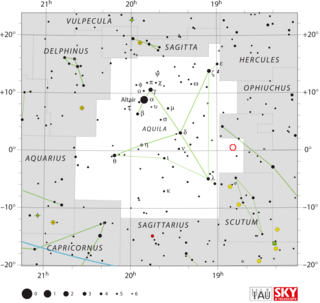
V603 Aquilae was a bright nova first observed in the constellation Aquila in 1918. It was the brightest "new star" to appear in the sky since Kepler's Supernova in 1604. Like all novae, it is a binary system, comprising a white dwarf and donor low-mass star in close orbit to the point of being only semidetached. The white dwarf sucks matter off its companion, which has filled its Roche lobe, onto its accretion disk and surface until the excess material is blown off in a thermonuclear event. This material then forms an expanding shell, which eventually thins out and disappears.
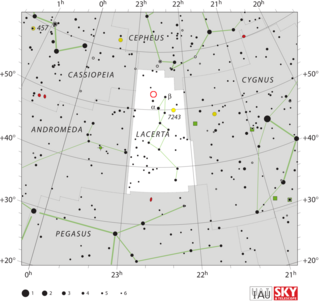
DI Lacertae or Nova Lacertae 1910 was a nova in constellation Lacerta which appeared in 1910. It was discovered by Thomas Henry Espinell Compton Espin at Wolsingham Observatory on 30 Dec 1910, at which time it was an 8th magnitude object. Subsequent examination of pre-discovery photographic plates showed that the outburst occurred sometime between 17 November 1910 and 23 November 1910. It reached a peak brightness of magnitude 4.6 on 26 November 1910, making it visible to the naked eye. Before the nova event DI Lacertae was a 14th magnitude star, and by 1950 it had returned to 14th magnitude.

BT Monocerotis was a nova, which lit up in the constellation Monoceros in 1939. It was discovered on a spectral plate by Fred L. Whipple on December 23, 1939. BT Monocerotis is believed to have reached mag 4.5, which would have made it visible to the naked eye, but that value is an extrapolation; the nova was not observed at peak brightness Its brightness decreased after the outbreak by 3 magnitudes in 182 days, making it a "slow nova". The light curve for the eruption had a long plateau period.
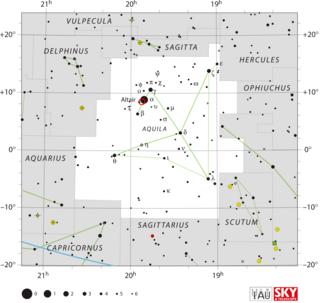
V500 Aquilae also known as Nova Aquilae 1943 was a nova which appeared in the constellation Aquila, very near the star Altair, in 1943. It was discovered by Cuno Hoffmeister on photographic plates taken at Sonneberg Observatory on 5 September 1943, when it had a photographic magnitude of 12. It reached its peak brightness sometime between 13 April 1943 when it was fainter than photographic magnitude 13.5, and 2 May 1943 when its photographic magnitude was 6.55.

HR Lyrae or Nova Lyrae 1919 was a nova which occurred in the constellation Lyra in 1919. Its discovery was announced by Johanna C. Mackie on 6 December 1919. She discovered it while examining photographic plates taken at the Harvard College Observatory. The bulletin announcing the discovery states "Between December 4 and 6 it rose rapidly from the sixteenth magnitude or fainter, to a maximum of about 6.5". It was the first nova ever reported in Lyra, and Mackie was awarded the AAVSO gold medal for her discovery. Its peak magnitude of 6.5 implies that it might have been visible to the naked eye, under ideal conditions.
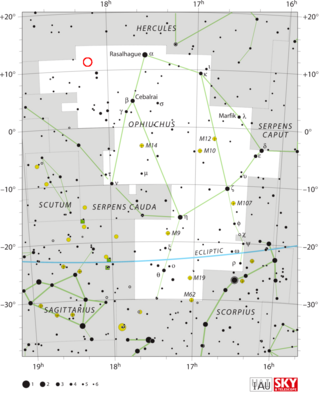
V849 Ophiuchi or Nova Ophiuchi 1919 was a nova that erupted in 1919, in the constellation Ophiuchus, and reached a blue band brightness of magnitude 7.2. Joanna C. S. Mackie discovered the star while she was examining Harvard College Observatory photographic plates. The earliest plate it was visible on was exposed on August 20, 1919, when the star was at magnitude 9.4. It reached magnitude 7.5 on September 13 of that year. In its quiescent state it has a visual magnitude of about 18.8. V849 Ophiuchi is classified as a "slow nova"; it took six months for it to fade by three magnitudes.

V604 Aquilae or Nova Aquilae 1905 is a nova which was first observed in the constellation Aquila in 1905 with a maximum brightness of magnitude 7.6. It was never bright enough to be seen with the naked eye. It was discovered by Williamina Fleming on a Harvard College Observatory photographic plate taken on August 31, 1905. Examination of plates taken earlier indicates that peak brightness occurred in mid-August 1905. The star's quiescent visual band brightness is 19.6.

DK Lacertae was a nova, which lit up in the constellation Lacerta in 1950. The nova was discovered by Charles Bertaud of the Paris Observatory on a photographic plate taken on 23 January 1950. At the time of its discovery, it had an apparent magnitude of 6.1. DK Lacertae reached peak magnitude 5.0, making it easily visible to the naked eye.
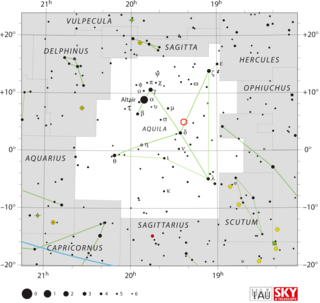
V1494 Aquilae or Nova Aquilae 1999 b was a nova which occurred during 1999 in the constellation Aquila and reached a brightness of magnitude 3.9 on 2 December 1999. making it easily visible to the naked eye. The nova was discovered with 14×100 binoculars by Alfredo Pereira of Cabo da Roca, Portugal at 18:50 UT on 1 December 1999, when it had a visual magnitude of 6.0.

V1059 Sagittarii was a nova, which lit up in 1898 in the constellation Sagittarius. The star reached apparent magnitude 4.5, making it easily visible to the naked eye. It was discovered on 8 March 1898, by Williamina Fleming on a photographic plate taken at the Harvard College Observatory. The discovery plate was an objective prism plate, part of the Henry Draper Memorial Photographs, and Ms Fleming identified it as a nova based on its spectral characteristics.

V606 Aquilae was a nova, which lit up in the constellation Aquila in 1899. The brightest reported magnitude for this nova was apparent magnitude 5.5, making it a naked eye object. It was discovered by Williamina Fleming on a photographic plate taken on 21 April 1899 at the Harvard College Observatory. On the discovery plate, its photographic magnitude was later determined to be 6.75. It was not seen on the plate taken on 1 November 1898, and there were no reported observations of the region around the star during the 171 day interval before Fleming's discovery, so it is possible that the actual maximum of the event was missed. By 27 October 1899 it had faded to 10th magnitude, and on 9 July 1900 Oliver Wendell reported its brightness to be between magnitude 11.5 and 12.0.
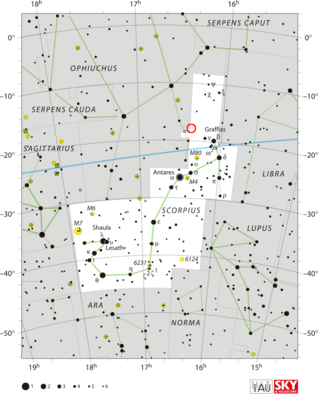
U Scorpii is a recurrent nova system; one of 10 known recurring novae in the Milky Way galaxy. Located near the northern edge of the constellation Scorpius it normally has a magnitude of 18, but reaches a magnitude of about 8 during outbursts. Outbursts have been observed in 1863, 1906, 1936, 1979, 1987, 1999, 2010, and 2022.

RW Ursae Minoris is a cataclysmic variable star system that flared up as a nova in the constellation Ursa Minor in 1956.

V1017 Sagittarii is a cataclysmic variable star system in the constellation Sagittarius. It first erupted in 1919, reaching magnitude 7. Its other eruptions in 1901, 1973 and 1991 only reached magnitude 10, leading it to be reclassified from a recurrent nova to a dwarf nova.
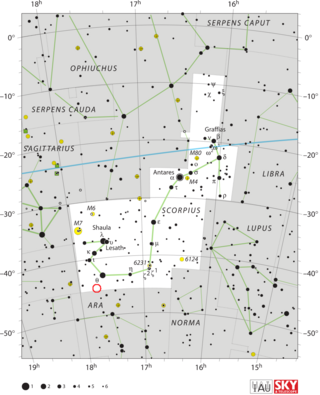
V728 Scorpii, also known as Nova Scorpii 1862, was a nova that occurred in the constellation of Scorpius. It was discovered on 4 October 1862 by John Tebbutt, an astronomer living in New South Wales, Australia, while he was observing a comet. He reported that the star was in the constellation Ara. At the time of its discovery, the nova had an apparent magnitude of 5, making it visible to the unaided eye. Nine days later it had faded to below 11th magnitude, indicating that it was a very fast nova.

V368 Aquilae, also known as Nova Aquilae 1936 no. 2 was the second nova which occurred in the constellation of Aquila during 1936. It was discovered on a photographic plate by Nils Tamm at Kvistaberg Observatory on 7 October 1936. At the time of discovery it was at photographic magnitude 7, and was already fading. Pre-discovery photographs showed that peak brightness occurred around 25 September 1936, at which time it had reached apparent magnitude 5.0, making it visible to the naked eye. The nova was described as being fiery red due to strong Hα emission, and for a time could be seen with binoculars simultaneously with V356 Aquilae, another nova which Nill Tamm had discovered a month earlier.

QZ Aurigae, also known as Nova Aurigae 1964, was a nova which occurred in the constellation Auriga during 1964. It was discovered by Nicholas Sanduleak on an objective prism photographic plate taken at the Warner and Swasey Observatory on 4 November 1964. Examination of pre-discovery plates from Sonneberg Observatory showed that the eruption occurred in early February 1964, and it had a photographic magnitude of 6.0 on 14 February 1964. Its brightness declined in images taken after the 14th, suggesting that its peak brightness was above 6.0. It was probably visible to the naked eye for a short time.
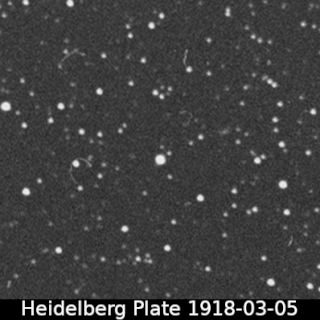
GI Monocerotis, also known as Nova Monocerotis 1918, was a nova that erupted in the constellation Monoceros during 1918. It was discovered by Max Wolf on a photographic plate taken at the Heidelberg Observatory on 4 February 1918. At the time of its discovery, it had a photographic magnitude of 8.5, and had already passed its peak brightness. A search of plates taken at the Harvard College Observatory showed that it had a photographic magnitude of 5.4 on 1 January 1918, so it would have been visible to the naked eye around that time. By March 1918 it had dropped to ninth or tenth magnitude. By November 1920 it was a little fainter than 15th magnitude.

V1370 Aquilae, also known as Nova Aquilae 1982, is a nova that appeared in the constellation Aquila during 1982. It was discovered by Minoru Honda of Kurashiki, Japan at 20:30 UT on 27 January 1982. At that time the Sun had moved just far enough from Aquila to allow the nova to be seen in the morning sky. Although it was discovered photographically, its apparent magnitude was 6–7, making it potentially visible to the naked eye under ideal conditions. A possible magnitude 20 progenitor was located on the Palomar Sky Survey prints. Spectra of the object were taken in February 1982 at Asiago Astrophysical Observatory, which confirmed that it is a nova.





















